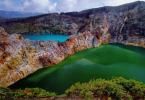It is a richly decorated fairytale palace, with dark red walls and a green roof. Windows and doors are framed in snow-white. Graceful turrets in the Old Russian style and battlements in the Gothic style. The palace is difficult to attribute to any one architectural movement. There is a successful combination of several here. Further, seven columns support the glass dome of the winter garden. The interior decoration of the castle is incomparable. Particularly noteworthy is the sophistication of the “Eastern Cabinet”, “Picture Gallery”, “Oak Room”. There are also magnificent fireplaces. One of them even contains a slab found during excavations in Pompeii.

After admiring the castle, you can stop for a rest here. The Sheremetyev estate is located good hotel, and very close by there is a cozy cafe. In addition, here, as throughout the republic, you can admire the amazing landscapes to your heart's content.
Museums
Continuing to describe the sights of Mari El, photos of which are presented in the article, one cannot help but talk about the museum of the city of Yoshkar-Ola. Those who want to learn about the history of the republic can visit it. You can learn about the traditions of the indigenous people at the Museum of Applied Arts. It is located in a modest one-story building with an attic. The city also has a museum of peasant labor and life. Its “highlight” is the rich collection of bells and bells.

More recently, the Tsarevokokshay Kremlin was built in the center of the capital. The impressive ancient Russian fortress made of red brick, walls and towers covered with a green roof, resembles the scenery of a historical film. This complex contains a church, archaeological museum and a monument to the founder of the city Fyodor Ioannovich.
Sights of Mari El: photos and descriptions
There is an unusual street sculpture in Yoshkar-Ola. It's called Yoshkin the cat. A representative of the bronze cat family sat imposingly on a bench, smiling condescendingly at passers-by.

Let's continue to describe the sights of Mari El. Five years ago it was opened quite significant monument. This is a bronze sculpture depicting the great Russian poet A.S. Pushkin and his most famous hero - Eugene Onegin.
What other interesting sights of Mari El? In the Italian Park of Yoshkar-Ola, the sculptural composition “Lorenzo di Piero de Medici the Magnificent” was recently installed, which symbolizes the triumph of science and art.
Churches and cathedrals
A monument of Russian church architecture is the church Holy Trinity. With the advent of Soviet power, it suffered the same fate as many churches in the country. It was closed and almost destroyed. The restored temple amazes with its splendor and marvelous architecture.
What other interesting sights of Mari El? For example, Orthodox shrine capital of the republic - the Cathedral of the Resurrection of Christ. This is aimed at the sky with its high towers a building with reddish walls with white stripes that visually increase the height of the structure. Green roofs and golden domes attract the gaze of a traveler amazed by this beauty for a long time.

In 2007, the Annunciation Tower was built in the central part of the city. The structure is 55 meters high and resembles a fragment of the Kremlin. Equipped with the most accurate clock, which is regulated by satellite.
Conclusion
Now you know the main attractions of Mari El. Photos with descriptions are presented in the article for clarity. We hope that the sights of the republic and information about them were interesting to you.
The Volga Republic was inhabited by ancient tribes since prehistoric times, which was facilitated by its location on the banks of the Volga, in a temperate continental climate. Indigenous people The Cheremis (now the Mari) began to be mentioned in chronicles from the 10th century, and already at that time they closely interacted with the Slavic tribes, despite being under the yoke of the Tatar yoke for quite a long time. Today, Mari El has wide opportunities for tourism, both recreational and educational, during which you can see many local attractions.
Museum of the History of Yoshkar-Ola
Opened about twenty years ago, the Museum of History of the capital of Mari El, Yoshkar-Ola, is one of the largest historical museums in the republic and a local landmark. It contains about 17 thousand exhibits that tell visitors about the history of the indigenous people - the Cheremis - who have inhabited these territories since ancient times. This story is illustrated by numerous archaeological finds, as well as household items of the ancient Mari, their jewelry, clothing, weapons and objects of applied art. Here visitors can see with their own eyes the recreated ancient trading shop of Tsarevokokshaisk (as Yoshkar-Ola was called before the revolution), as well as living quarters with ancient paraphernalia and furnishings.
National Park "Mari Forest" ("Mari Chodra")

This park, with a total area of almost one hundred thousand hectares, was created to preserve as much as possible and, if possible, increase natural resources Republic of Mari El. Here you can find tree species characteristic of these latitudes: pines, spruces, lindens, oaks, aspens, maples, elms and many others. Particularly protected are the relict linden-oak forests, which are still inhabited by brown bears, moose, wild boars and other representatives of the fauna of the middle zone. There are horseback riding and hiking trails throughout the park.
Museum of Applied Arts

Opened in 1999, the Museum of Applied Art of the Mari El Republic in Yoshkar-Ola is dedicated to introducing its visitors to the traditions of the indigenous Mari. A variety of objects and the fruits of the labor of local craftsmen are presented here: wicker furniture made of bird cherry, carved wooden dishes, skillfully made musical instruments and national everyday and festive costumes with rich embroidery. The attraction regularly hosts exhibitions of works by contemporary masters from all over the republic.
Tsarevokokshay Kremlin

This historical and educational complex was opened in the center of Yoshkar-Ola several years ago, but has already become one of the central attractions of the Mari El Republic. In ancient times, on the site of the Kremlin there were city fortifications, which were not preserved because they were built of wood. Then the city market was located here, and after the Revolution - central square. Today it is a city park, enclosed by a massive wall with four towers; specially cast cannons are placed along the wall. On its territory there is a church, cozy benches for walkers, and also scattered information stands where the history of the city is described in detail. Here is also the archaeological museum of Yoshkar-Ola and the only monument to its founder Fyodor Ioannovich.
Museum of Peasant Labor and Life

This attraction of the Republic of Mari El is more often mentioned in guidebooks as the Museum of Bells. This is due to the fact that a unique collection of bells and bells for various purposes, produced in different times on the territory of Russia. In fact, there are just over a hundred of them, which is only a small part of the attraction's 2,000 exhibits. In addition to bells, a variety of labor tools are presented here, with the help of which many centuries ago the indigenous Mari cultivated the land, grazed livestock, built houses and created comfort in them. Here you can also find objects of local applied arts, exhibitions of contemporary works, as well as photographs of past years.
Pugachev Oak

This ancient tree, found in Mari Chodra Park, is one of the few plants listed as a National Treasure and a local landmark. This powerful oak tree in Mari El, whose age, according to experts, has already exceeded four centuries, is famous for the fact that it was from its branches that the famous Emelyan Pugachev watched the fire in Kazan, which he himself started in retaliation for the city’s reluctance to surrender to his mercy .
Sculpture "Tree of Life"

This bronze monument is installed in the central city park of the capital of Mari El, Yoshkar-Ola, and is a unique landmark of the city. It depicts an old man, a man and a boy who, under the shade of a small tree, play traditional Mari musical instruments- harp, pipe and drum. The landmark is intended to represent the connection between generations, as well as the historical and cultural heritage republics.
Natural attractions of Mari El are monuments natural heritage With interesting story. Natural attractions of Mari El are natural heritage monuments with an interesting history. Many places are unique and have national significance. Many places are unique and have national significance. Sanatoriums, reserves, natural national parks. Sanatoriums, nature reserves, and natural national parks have been created and are operating.

The Republic of Mari El is located in the east of the East European Plain in the middle part of the Volga River basin. From the north, northeast and east, our republic borders on the Kirov region. From the southeast and south with the Republics of Tatarstan and Chuvashia, and in the west and northwest - with Nizhny Novgorod region. The length of its borders exceeds 1200 km, and total area equal to 23.3 thousand sq. km. The capital of Mari-El is Yoshkar-Ola. There is a lot of interesting things in the Mari-El Republic. Let's look at some of the natural attractions that our native land is rich in.

Sea Eye From the depths of a karst hole, the Sea Eye is looking at us - that’s the name of the famous local lake. They dubbed it so for its regular round shape and amazing emerald color of water. Green algae give this color to the lake. According to one version, the reservoir appeared 20 thousand years ago - back in the Ice Age! Many ancient legends are associated with the Sea Eye. From the depths of the karst hole, the Sea Eye is looking at us - that’s the name of the famous local lake. They dubbed it so for its regular round shape and amazing emerald color of water. Green algae give this color to the lake. According to one version, the reservoir appeared 20 thousand years ago - back in the Ice Age! Many ancient legends are associated with the Sea Eye.

Castle of Count Sheremetyev On the left bank of the Volga, in the village of Yurino, a castle similar to a medieval one, with crenellated towers, colored stained glass windows, and a domed winter garden, attracts the attention of tourists. This is the castle of Count Sheremetyev. Covered in legends, it attracts with unknown mystery and unique beauty. On the left bank of the Volga, in the village of Yurino, a castle that looks like a medieval one, with crenellated towers, colored stained glass windows, and a domed winter garden, attracts the attention of tourists. This is the castle of Count Sheremetyev. Covered in legends, it attracts with unknown mystery and unique beauty.


Temple of the Archangel Michael In the center of the village of Yurino, famous for its Sheremetyevsky Castle, among the trees the Temple of the Archangel Michael rises majestically - one of the most magnificent Orthodox buildings on the land of Mari El. This church is often called the pearl of the entire Volga region. In the center of the village of Yurino, famous for its Sheremetyevsky Castle, the Church of the Archangel Michael rises majestically among the trees - one of the most magnificent Orthodox buildings on the land of Mari El. This church is often called the pearl of the entire Volga region.

National Park"Mari Chodra" Established in 1985, the Mari Chodra National Park is an interesting natural-territorial complex. Numerous mineral springs, significant outlets of which are located in the valleys of the Ilet and Yushut rivers, are used for medicinal purposes in sanatoriums, rest homes and hospitals. A characteristic element of the landscape are lakes (sinkholes, inter-dunes, floodplains). Established in 1985, the Mari Chodra National Park is an interesting natural-territorial complex. Numerous mineral springs, significant outlets of which are located in the valleys of the Ilet and Yushut rivers, are used for medicinal purposes in sanatoriums, rest homes and hospitals. A characteristic element of the landscape are lakes (sinkholes, inter-dunes, floodplains).

Pugachev's Oak Located on Maple Mountain, the Mari Chodra National Park is an interesting natural-territorial complex. The oldest specimen of oak, called Pugachevsky, has been preserved here. According to legend, under the shade of this oak tree E. I. Pugachev stopped for the night with his detachment. The oak differs sharply in its size among the forest stand. This is a gigantic tree with a powerful trunk, the diameter of which is 159 cm, which is part of the upper tier. The Mari Chodra National Park, located on Klenovaya Mountain, is an interesting natural-territorial complex. The oldest specimen of oak, called Pugachevsky, has been preserved here. According to legend, under the shade of this oak tree E. I. Pugachev stopped for the night with his detachment. The oak differs sharply in its size among the forest stand. This is a gigantic tree with a powerful trunk, the diameter of which is 159 cm, which is part of the upper tier.

Reserve "Bolshaya Kokshaga" State reserve"Bolshaya Kokshaga" was created on March 14, 1993. The reserve was created to protect forest ecosystems on the border of southern taiga and broad-leaved forests. The reserve preserves intact plant communities: forests, swamps, meadows, which are habitats for animals and the growth of many rare and endangered plants. The Bolshaya Kokshaga State Nature Reserve was created on March 14, 1993. The reserve was created to protect forest ecosystems on the border of southern taiga and broad-leaved forests. The reserve preserves intact plant communities: forests, swamps, meadows, which are habitats for animals and the growth of many rare and endangered plants.

Green Spring At the foot of Klenovaya Mountain a sulfate-bicarbonate calcium-magnesium spring flows into the Ilet River. It is formed from a system of springs flowing directly from the ground. The largest of them is called the Green Key. At the foot of Klenovaya Mountain, a sulfate-bicarbonate calcium-magnesium spring flows into the Ilet River. It is formed from a system of springs flowing directly from the ground. The largest of them is called the Green Key.


Stone Mountain Stone Mountain is a large hill with a rock on its surface. There is a spring on the mountain, and there is a table with benches. This is an amazing place to relax. Below, under the steep slopes, there is a dense forest. A stone mountain is a large hill with a rock on its surface. There is a spring on the mountain, and there is a table with benches. This is an amazing place to relax. Below, under the steep slopes, there is a dense forest.


Immediately after Atlant with a stone, the road goes to the village of Gornyak. There, in the forests behind the village, far from prying eyes and well-trodden paths, ancient quarries are hidden. This is a whole network of caves, hand-hewn by people. Since ancient times, millstones for mills have been mined here. Samples of such stones lie in front of the caves. Inside there is permafrost. Even in the hottest weather, the ice in the caves does not melt. Immediately after Atlant with a stone, the road goes to the village of Gornyak. There, in the forests behind the village, far from prying eyes and well-trodden paths, ancient quarries are hidden. This is a whole network of caves, hand-hewn by people. Since ancient times, millstones for mills have been mined here. Samples of such stones lie in front of the caves. Inside there is permafrost. Even in the hottest weather, the ice in the caves does not melt.





